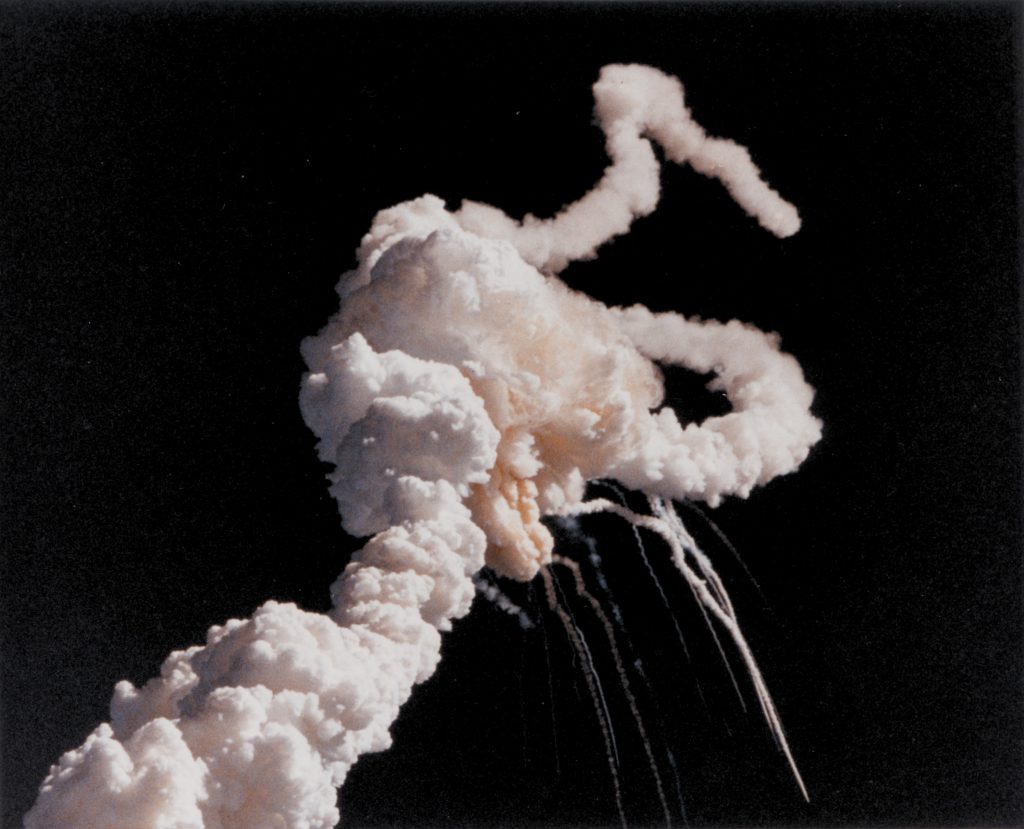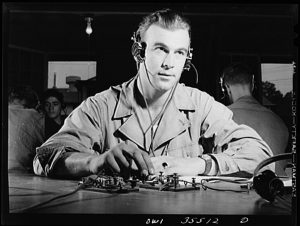On the evening of January 27th, 1986, an engineer at a little-known company told his wife, “It’s going to blow up.” That man was Bob Ebeling, an engineer for Morton Thiokol, which had been contracted to manufacture and maintain the solid rocket booster (SRB) used by NASA’s space shuttle program. On that night, he and his coworkers tirelessly pleaded with NASA officials to delay the launch of the space shuttle Challenger until temperatures were more favorable. Sadly, NASA officials did not heed these warnings, and all seven crew members of STS 51-L lost their lives.1
This story starts before that tragic day with the creation of the space shuttle program. As you can imagine, any vehicle designed for space undergoes rigorous testing and analysis before being put into use. During these early tests, engineers at the Marshall Space Flight Center saw a potentially catastrophic flaw in the two o-ring design that the SRB used in its joints and reported their concerns to NASA in 1971. NASA disregarded these concerns and did not pass this report onto Morton Thiokol for further evaluation. NASA approved the shuttle program and put the shuttles into production. By the second shuttle mission, there was serious evidence that supported the original concerns for the SRB o-ring failure. The evidence continued to stack up with each subsequent mission. In 1985 Morton Thiokol decided to redesign the joint to include an additional three inches of steel, which would grip the inner face of the joint and prevent it from rotating and potentially failing. Both NASA and Morton Thiokol agreed to continue with the launch schedule while they worked on this fix and accepted the potential for failure as an acceptable flight risk.2
Despite this risk, no shuttle had ever suffered a catastrophic failure during launch, orbit, re-entry, and no crew member had ever been injured or killed during a mission. The Challenger had already completed nine successful missions at this point and future missions were continuously being planned. This perfect record was a point of pride for NASA, and confidence continued to grow. This confidence caused NASA to be overly optimistic in their promise of how cost effective and efficient the shuttle program could be. These promises resulted in immense pressure from the government and tax payers to deliver on their promises with an overly ambitious launch schedule.3
The launch of STS 51-L had been planned as the first launch of 1986, and it would also put the first teacher in space. The addition of Christa McAuliffe, an elementary school teacher from New Hampshire, to the mission had garnered national and international attention. The launch was scheduled for January 22, 1986, but due to the delay of other missions, the launch of 51-L was pushed back several times — first to January 23rd, then to the 24th, 25th, 26th, and finally the 27th. On the morning of the 27th during regular countdown procedures, a micro switch indicated a failure of an exterior hatch-locking mechanism. By the time this issue was fixed, the winds had exceeded launch criteria. The launch was delayed yet again.4

Managers at Morton Thiokol had been watching the delays from their headquarters in Utah and were tracking the conditions with each delay. On the evening of the 27th, they saw the temperature would be below freezing at the launch site the next morning, which presented potential problems, raising concern. The shuttle and SRB had never been certified to operate in temperatures that low. Bob Ebeling had written an official memo for NASA titled “Help!” in 1985 where he described the extremely high potential for both o-rings to fail in temperatures below 40°F, but NASA had ignored it. That evening a manager at Morton Thiokol called Ebeling to ask if the shuttle could launch the following morning in the freezing temperatures. When Ebeling informed them of the extreme risk, they immediately started crunching the numbers and building their argument for the delay of the launch. Morton Thiokol and NASA held a teleconference. NASA opposed all arguments for a delay, and stated that if one o-ring failed there was a secondary mechanism that would stop a catastrophic failure from happening. Morton Thiokol engineers continued to explain that was an incorrect assumption that would surely lead to disaster. Sadly, NASA officials disagreed, and a second teleconference was scheduled. Except this time, the Morton Thiokol engineers were excluded, only management from NASA and Morton Thiokol were included. In this second call Morton Thiokol management disregarded the warnings of their own engineers and recommended that the launch proceed as scheduled.5

At 11:38AM on January 28th, 1986, STS 51-L launched from Cape Canaveral, Florida. On board were seven crew members: Francis Scobee, Michael Smith, Ronald McNair, Ellison Onizuka, Judith Resnik, Gregory Jarvis and Christa McAuliffe. At 11:39:13AM, just 73 seconds after launch, the space shuttle Challenger broke apart at an altitude of 14,000 meters. All crew members were killed when their cabin plummeted into the Atlantic Ocean three minutes after the break up.6
This disaster led to the immediate grounding of all shuttle missions. President Reagan convened a commission, called the Rogers Commission, to investigate the Challenger disaster. The results of the investigation showed the mechanical cause of the break up was a failure in both o-ring seals, which led to catastrophic structural failure. The report more importantly considered the contributing causes of the accident. It concluded that both NASA and Morton Thiokol failed to respond adequately to the potential danger of the SRB design, and instead of taking immediate action they accepted it as a flight risk. It also uncovered the large disconnect between management and engineers, which led to people who didn’t truly understand the science and math making a decision that was based on pride instead of fact.7

These tragic events unfolded more than three decades ago but are relevant today more than ever. The first private civilian space mission is rapidly approaching, and as it draws closer, we have to look closely at our past mistakes. If we don’t we are destined to repeat them. The millions who watched these events unfold have not forgotten how horrified they were, and they also remember how much the nation was shaken from this tragedy. Ebeling sums these feelings up best when describing how he feels looking back at what happened, “I could have done more. I should have done more.”8 We need to do our best to get everything right the first time, especially when failure equates to lives lost. We need to continue to focus on this as space travel becomes more prevalent in our society, and like Morton Thiokol and NASA in the ’80s, we can’t value our pride more than human lives.
- Howard Berkes, “30 Years After Explosion, Challenger Engineer Still Blames Himself,” NPR, January 28, 2016, https://www.npr.org. ↵
- Wikipedia, 2018, s.v. “Space Shuttle Challenger Disaster,” https://en.wikipedia.org/wiki/Space_Shuttle_Challenger_disaster. ↵
- Howard Berkes, “30 Years After Explosion, Challenger Engineer Still Blames Himself,” NPR, January 28, 2016, https://www.npr.org. ↵
- Diane Vaughn, The Challenger Launch Decision: Risky Technology, Culture and Deviance at NASA, Enlarged Edition (Chicago, IL: University of Chicago Press, 2016), 1-3. ↵
- Wikipedia, 2018, s.v. “Space Shuttle Challenger Disaster,” https://en.wikipedia.org/wiki/Space_Shuttle_Challenger_disaster. ↵
- Funk & Wagnalls New World Encyclopedia, 2017, s.v. “Challenger Disaster.” ↵
- Wikipedia, 2018, s.v. “Space Shuttle Challenger Disaster,” https://en.wikipedia.org/wiki/Space_Shuttle_Challenger_disaster. ↵
- Howard Berkes, “30 Years After Explosion, Challenger Engineer Still Blames Himself,” NPR, January 28, 2016, https://www.npr.org. ↵



96 comments
Scott Sleeter
This is a great breakdown of the Challenger disaster. It makes for a very compelling story. It is too bad that it could not have had a happier ending with the engineers being the heroes and saving the lives of those brave astronauts. The whole disaster was caused by NASA’s overconfidence in their abilities and not paying attention to the people that knew how the equipment really worked.
Shine Trabucco
This is always so sad for me. The emotional impact you are able to make towards the readers in really important. The photos you use add to this seeing the faces and the factors that contributed to the failure are really impactful. I was really pulled in by the quote you used at the beginning “It’s going to blow up” and then the quote at the end. The two really tie the knot for the article
John Cadena
Similar to another article in this assignment, the use of detail was really well used in this piece. For a reader who holds a significant interest in this topic, the use of time stamped progression really helps the reader move along and feel a part of the story.
John Cadena
Very good use of space, in this story about space. As it began the scene was set well in that as it progressed, I was able to follow the story and understand the rise and fall of action from take off to combustion
Gabriel Cohen
This launch was a historic milestone, and I think you did a great job of relaying the significance of the disaster. Sometimes the most powerful trans-formative experiences in the history of human progress are the ones that end in catastrophe.
Edgar Velazquez Reynald
Thank you for this article. The Challenger is one of those tragedies that could’ve easily been avoided. Its sad to know that the warnings of those engineers fell on deaf ears, simply due to bureaucratic reasons. Your pacing and well structured paragraphs made this a very engaging read.
Danielle A. Garza
You made something that could have been very boring to some readers, exciting and enjoyable to read. Taking this large story and condensing it to three major players and their interaction is wonderful. Most of the time when one hears of this story they hear the life of those who died like the teacher. That is worth knowing yet one never really tells you why they perished. That there was a crisis happening on the ground a long time before the flight even took off.
Lindsey Wieck
Tyler, this article is now a required reading in my graduate Advanced Public History methods course!
Tyler Boyd
That’s awesome to hear, quite an honor! Thanks Dr. Wieck, couldn’t have done it without your help.
Sara Ramirez
This is a terrible blight on the history of space travel. This story is especially tragic because it could have so easily been prevented had NASA and management heeded the warnings of the engineers who advised against the launch. I think this story serves as a lesson against disregarding the advice of experts in the field. Among other things, public policy should be influenced by scientists and engineers knowledgeable in their respective field. Great article!
Mario Sosa
Excellent well-constructed article! I remember recently seeing footage of NASA’s mission control staff members watching the event unfold in pure shock. You could see them internally breaking down. I am assuming that NASA up to this point had become overconfident, since there had been no fatalities before 1986 and they have insisted on taking risks. It is unfortunate that it took the Challenger exploding for NASA to realize that they should have focused more on the safety of others.